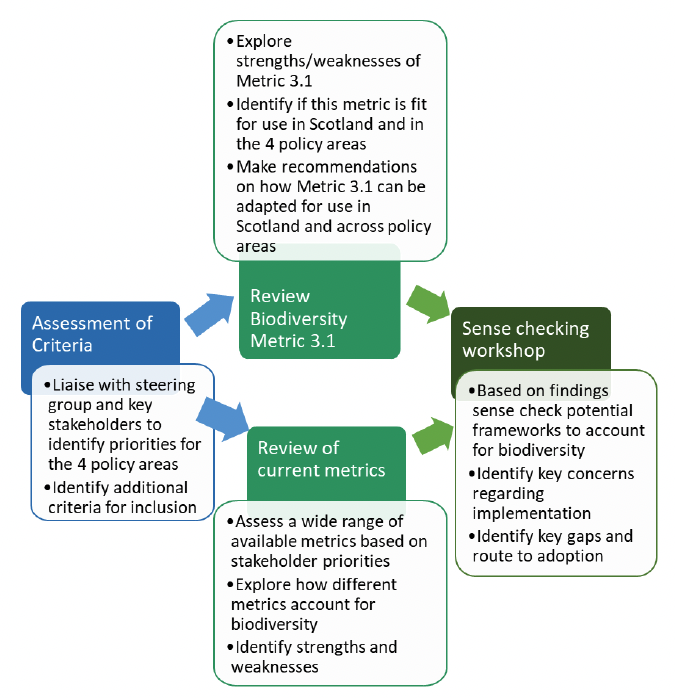Measuring biodiversity: research into approaches
This report considers methodologies for measuring biodiversity at site-level for use in Scotland.
Introduction
The Scottish Government's National Strategy for Economic Transformation highlights the importance of a nature-positive economy to address both the climate and nature emergencies. Further, Scotland's Biodiversity strategy aims to establish a shared vision for biodiversity: "by 2045 we will have substantially restored and regenerated biodiversity across our land, freshwater and seas". It sets out two high-level goals: to be nature-positive by 2030, bending the curve to halt biodiversity loss; and to restore biodiversity in Scotland by 2045. Two key delivery vehicles are the global 30x30 target of protecting at least 30% of land and seas for nature by 2030 and creating Nature Networks across Scotland to enhance ecosystem health, sustainability, and resilience.
Scotland has a comprehensive suite of biodiversity indicators to assess broad trends in biodiversity at the national level, however, it is lacking a consistent means to assess biodiversity at the site scale. Reversing biodiversity declines will require action across multiple strands of policy. These include agriculture, conservation and biodiversity monitoring, planning and development, and natural capital markets. To enable biodiversity recovery actions and measure their success, robust biodiversity metrics, and associated tools to measure these metrics, are required that are fit for purpose and allow comparision and trading across policy sectors. Biodiversity metrics are also needed in relation to the Natural Environment Bill targets to demonstrate the need for and subsequent effect of interventions.
Looking across the UK and internationally, a number of biodiversity metrics and measurement tools have been developed in recent years to address the needs of end-users across these different policy areas. These include tools to inform biodiversity offsetting or net gain to quantify biodiversity loss due to development alongside biodiversity gain through mitigating actions including habitat creation or enhancement. Other tools are targeted to enable businesses to identify and report on their biodiversity impacts at project, site or corporate level. Approaches range from those requiring on-site surveying to those that draw on modelling and knowledge of biodiversity impacts of different land uses and management actions. Natural capital markets for biodiversity credits are also being underpinned by an increasing number of metrics and standards. These markets include investment opportunities around nature recovery and net gain or offsetting opportunities reflecting both
This initial exploratory study draws on stakeholder knowledge and opinions, alongside an evaluation of existing tools, to provide recommendations on how a Scottish 'biodiversity metric' or framework could be developed to assess Biodiversity at site level (Figure 1).

Aims and objectives
This project aims to provide guidance to aid the development of a framework to enable Scotland to monitor and account for biodiversity at the site level. This framework will consider the end-user needs across four key policy areas – specifically Agriculture, Conservation and Biodiversity Monitoring, Natural Capital Markets and Planning and Development.
Objectives
1. Work with stakeholders to identify relevant criteria against which to assess existing metrics or tools and determine the priority of these criteria with respect to policy area.
2. Assess a wide range of biodiversity metrics and tools targetted to measure biodiversity at the site level and determine which aspects of current approaches meet the needs of end-users in Scotland.
3. Specific analysis of the applicability to Scottish needs of the Natural England's Biodiversity Metric 3.1 being used as the basis of a new biodiversity standard, and possible adaptations that would make it fit for use in Scotland.
4. Work with stakeholders to sense check key findings, identify concerns, and ensure that final guidance aligns with stakeholder requirements and needs.
5. Drawing on the above, advise on preferred approach and scope of guidance that will be required.
Contact
Email: katherine.pollard@gov.scot
There is a problem
Thanks for your feedback